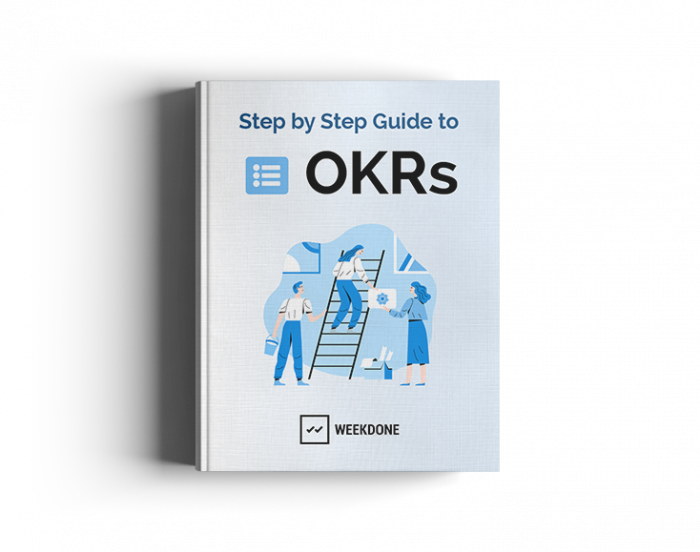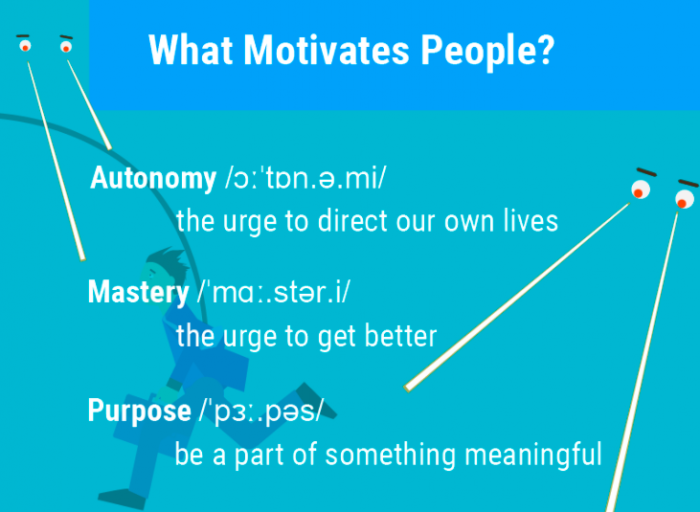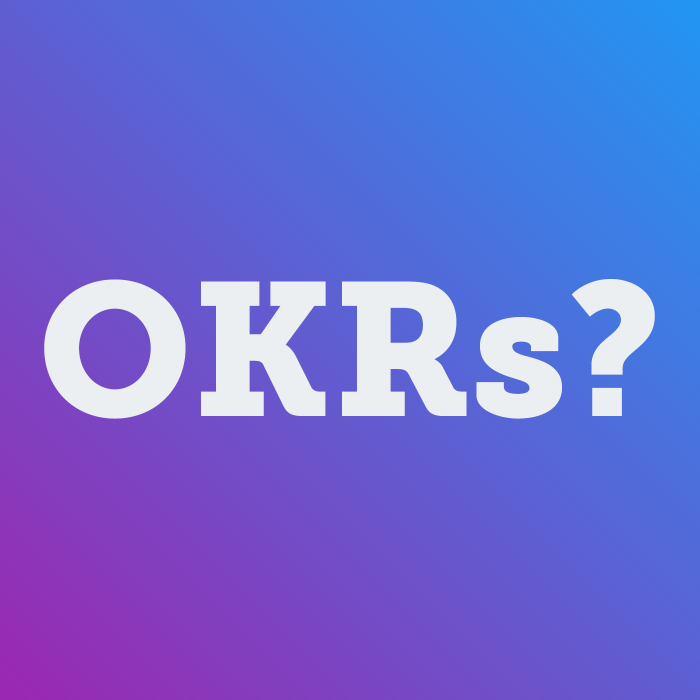It was more than 2 years ago when I first started working at Weekdone. And it was the first time I had a team to run. It was also the first time I had to use the OKR process – Objectives and Key Results. I had heard of the methodology and looked into it before. Nevertheless, It was still a little hard to get started as I didn’t have as many educational materials as there are today.
I am sharing my own experience. Because I wish I had had someone, or at least some materials, to guide me through the process of setting OKRs for the first time as a team leader. I am going to share how I got started, what mistakes to avoid, how to get the team involved.
How to Get Started With the OKR Process?
First of all, get to know the basics of the OKR methodology. In short, OKRs consist of a list of objectives. Under each objective there are usually 3-4 key measurable results. Each key result has a progress indicator or score of 0-100% or 0 to 1.0 that shows its achievement.
If you understand the basics of the OKR process, then I would urge you to get started with a practical exercise of setting your first objectives:
- Determine the primary factor driving your company/team right now. Got it?
- Now, establish 1-3 key results that will measure your ability to reach that objective. The key results are often numerical. They should be based on growth, performance, revenue, or engagement. Take a look at the examples below to get a clearer understanding. Or visit this page for even more OKR examples categorized by different teams;
- Once you have completed drafting the first objective, add 1-2 objectives more. Just as a reminder, at first it is smart not to start with too many objectives;
- Now that you have run through the OKR process, it is time to repeat the process company/team wide.
OKR Materials for the Beginners
OKR materials and resources I wish I had when I got started with OKRs:

- Step by Step Guide to OKRs (FREE). This is a “How-to” guide for getting started with OKRs. This will help your team and company implement the best goal setting system currently out there. It consists of history, framework, templates, examples and practical guidelines;
- The Objectives and Key Results page. A page that gives detailed information on how to implement the OKR system;
- Top 10 Questions Managers Have About OKR Goal Setting (Examples and Templates);
- OKR examples. There are example OKRs for a variety of teams and departments: Marketing, Sales, Finance/Accounting, Product Management, HR, Customer Service, Engineering and more;
- Employee guide to getting started with OKRs;
- OKRS at Google: A Case Study;
- And OKR case studies. Learn how other companies are using OKRs.
Things to Avoid When Starting Out With the OKR Process
These are all based on the mistakes I or my team made over the course of the 2 years when setting OKRs. Now looking at them, I find myself understanding that it is actually really good to have some clarity on what not to do. Mainly because OKR framework has a lot of wiggle room and the more clarity you have the better. Nevertheless, one part of setting OKRs is constantly adjusting and improving. Therefore, I urge and encourage you to make your own mistakes.
Don’t list too many objectives. It is the number one mistake me and everybody else make. Just last quarter I realised that I have been listing too many objectives for one quarter. Funnily enough, this year we set our OKRs for one month and what ended up happening was that the amount of objectives for one month was the perfect amount for one quarter. So, if you find yourself struggling with too many objectives, set them for one month first and plan to execute them in one quarter.
Make sure your objectives align with the company objective(s). The whole point of OKRs is so that everybody will move in the same direction as a company. Always start with your company objectives. This doesn’t mean that you have to set the OKRs from top to bottom, but make sure you have one direction in place, so that everybody can align accordingly.
Objectives have to be challenging. Objectives are your goals that are aspirational, challenging, qualitative, time bound, and unambiguous. In fact, with OKRs you should aim for 70% achievement rate. Otherwise, your goals were not ambitious enough.
Keep metrics out of objectives. Objectives are the “What?” and key results the “How?”.
You and Your Key Results
- Your Key Results have to be numeric and measurable. Thet are the evaluation of achievement. The “How?”. It can be: 0-100% progress, dollars, items, units, articles, people, grade rating, project phases:
- Make sure you have key results that measure success relevant to your objectives. As stated in the previous point, key results represent the “how?”: How are you going to achieve that particular Objective?
- Spend more time setting your OKRs. Often times OKRs are set for one quarter, so your team or company success can really depend on how you set your OKRs. Therefore, I suggest that you start by setting objectives 2-4 weeks before the next quarter, so that you will have enough time to discuss and set objectives with your team;
- Include your whole team in the OKR setting process. As a team manager, I asked my team members to propose their activities for this quarter considering the overall theme of being the best OKR software out there;
- Write your objectives so that even your grandmother would understand. OKRs are not only for yourself, but everyone. OKRs are meant to bring clarity and unity to the whole company. Its structure can even help you to understand who is working in what team. Keeping that in mind, write your OKRs so that everyone would understand.
- Visit your objectives weekly. OKRs work the best if everybody views and updates them regularly;
- Make sure key results have an equal value. Let’s say you have one objective and 3 key results. In theory, these 3 key results are each worth 33.3% of that one objective. Make sure the key results have almost an equal value, that way you make sure that the progress of your OKRs is equal as well;
- Make OKRs public. As stated earlier, OKRs are kept public, in front of everyone, so teams move in one direction and know what others are focusing on.
How to get the team on board the OKR process?
In my experience, you can’t really force a tool (or anything else in that matter) upon your team. The motivation to use or do something comes down to 3 factors:

In my opinion, OKR methodology is a perfect framework to fulfill all 3 factors. Therefore, start by explaining the benefits of OKRs to the team and how it will make their life easier. OKRs are designed so that everyone in the team will have a clear understanding of the big picture and knows what the indicators of success are.
For example, one of our clients told us: “The whole process has really helped people understand our, and their, expectations and what they need to do to be successful” – Shawn Rucks – CEO at deverus.

Benefits of OKRs
Therefore, I would start with the following benefits to get the employee buy-in to OKRs:
- Increase productivity by focusing on the right goals. It keeps the vision and goals in front of you at all times;
- Get praise and know what others are doing. By listing your quarterly or monthly goals and key results, everybody knows what you are focusing on and therefore don’t have to report as much. Also, it is easier to give feedback when everybody knows what you are up to.
Objectives and Key Results Work
OKR may not sound like the most exciting methodology in the world, but it works. Why else are companies like Slack, Netflix, Samsung, Asana, Spotify, Google, LinkedIn, Deloitte, Dropbox, Salesforce, Facebook, Intel, Gap, Amazon, and GoPro using them? In addition, normal small to medium enterprises use them. That is the beauty of OKRs, it works for any size company, it even works for individuals.
I urge you to be patient and involve everyone in the process of setting up OKRs. As said by one of our customers, Henry Mason from Trendwatching: “OKRs process helps the company to envision how success looks like”.
And to even improve your odds of implementing OKRs make sure you contact our customer support who are happy to give you and your team a demo of setting up your OKRs. Plan your demo here.



